
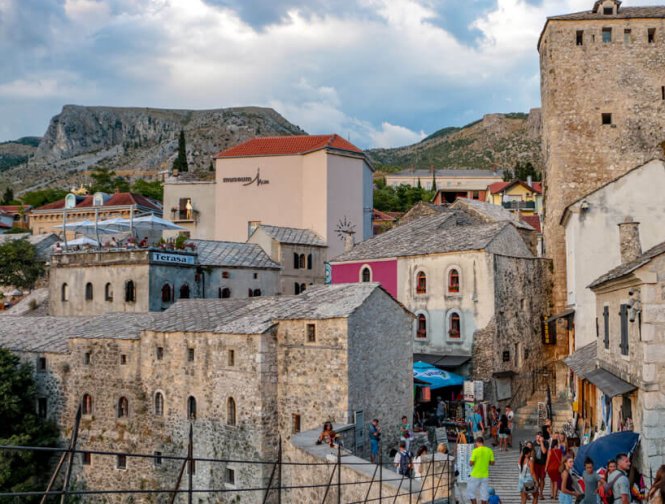
MOSTARHuman settlements on the river Neretva, between the Hum Hill and the Velež Mountain, have existed since prehistory, as witnessed by discoveries of fortified enceintes and cemeteries. Evidence of Roman occupation was discovered beneath the present town.As far as medieval Mostar goes, although the Christian basilicas of late antiquity remained in use, few historical sources were preserved and not much is known about this period. The name of Mostar was first mentioned in a document dating from 1474, taking its name from the bridge-keepers (mostari); this refers to the existence of a wooden bridge from the market on the left bank of the river which was used by traders, soldiers, and other travelers. During this time it was also the seat of a kadiluk (district with a regional judge). Since Mostar was on the trade route between the Adriatic and the mineral-rich regions of central Bosnia, the settlement began to spread to the right bank of the river. Prior to 1474 the names of two towns appear in medieval historical sources, along with their later medieval territories and properties – the towns of Nebojša and Cimski grad. In the early 15th century the county (župa) of Večenike covered the site of the present-day Mostar along the right bank of the Neretva, including the sites of Zahum, Cim, Ilići, Raštani and Vojno. It was at the center of this area, which in 1408 belonged to Radivojević, that Cim Fort was built (prior to 1443). Mostar is indirectly referred to in a 1454 charter of King Alfonso V of Aragon as Pons ("bridge"), for a bridge had already been built there. Prior to 1444, the Nebojša Tower was built on the left bank of the Neretva, which belonged to the late medieval county still known as Večenike or Večerić. The earliest documentary reference to Mostar as a settlement dates from 3 April 1452, when Ragusans from Dubrovnik wrote to their fellow countrymen in the service of Serbian Despot Đorđe Branković to say that Vladislav Hercegović had turned against his father Stjepan and occupied the town of Blagaj and other places, including “Duo Castelli al ponte de Neretua.”. In 1468 the region came under Ottoman rule and the urbanization of the settlement began. It was named Köprühisar, meaning fortress at the bridge, at the centre of which was a cluster of 15 houses. The town was organized into two distinct areas: čaršija, the crafts and commercial centre of the settlement, and mahala or a residential area. The town was fortified between the years 1520 and 1566, and the wooden bridge rebuilt in stone. The stone bridge, the Old Bridge (Stari Most), was erected in 1566 on the orders of Sultan Suleiman the Magnificent and at 28 metres long and 20 metres high, quickly became a wonder in its own time. Later becoming the city's symbol, the Old Bridge was designed by Mimar Hayruddin, a student and apprentice of Ottoman architect Mimar Sinan. In the late 16th century, Köprühisar was one of the towns of the Sanjak of Herzegovina. The traveler Evliya Çelebi wrote in the 17th century that: the bridge is like a rainbow arch soaring up to the skies, extending from one cliff to the other... I, a poor and miserable slave of Allah, have passed through 16 countries, but I have never seen such a high bridge. It is thrown from rock to rock as high as the sky. |
 |
 |
Austria-Hungary took control over Bosnia and Herzegovina in 1878 and ruled the country until the aftermath of World War I in 1918, when it became part of the State of Slovenes, Croats and Serbs and then Yugoslavia. During this period, Mostar was recognized as the unofficial capital of Herzegovina. The first church in the city of Mostar, a Serbian Orthodox Church, was built in 1834 during Ottoman rule. In 1881 the town became the seat of the Roman Catholic Diocese of Mostar-Duvno and in 1939, it became a part of the Banovina of Croatia. During World War II, Mostar was also an important city in the fascist Independent State of Croatia.After World War II, Mostar developed industries producing plastics, tobacco, bauxite, wine, aircraft and aluminium. Several dams (Grabovica, Salakovac, Mostar) were built in the region to harness the hydroelectric power of the Neretva. The city was a major industrial and tourist center and prospered economically during the time of the Socialist Federal Republic of Yugoslavia. After Bosnia and Herzegovina declared independence from Yugoslavia in April 1992, the town was besieged by the Yugoslav People's Army (JNA), following clashes between the JNA and Croat forces. The Croats were organized into the Croatian Defence Council (HVO) and were joined by a sizable number of Bosniaks. The JNA artillery periodically shelled neighbourhoods outside of their control from early April. On 7 June the Croatian Army (HV) launched an offensive code named Operation Jackal, the objective of which was to relieve Mostar and break the JNA siege of Dubrovnik. The offensive was supported by the HVO, which attacked the Army of Republika Srpska (VRS) positions around Mostar. By 12 June the HVO secured the western part of the city and by 21 June the VRS was completely pushed out from the eastern part. Numerous religious buildings and most of the city's bridges were destroyed or severely damaged during the fighting. Among them were the Catholic Cathedral of Mary, Mother of the Church, the Franciscan Church and Monastery, the Bishop's Palace and 12 out of 14 mosques in the city. After the VRS was pushed from the city, the Serbian Orthodox Žitomislić Monastery and the Cathedral of the Holy Trinity were demolished. Throughout late 1992, tensions between Croats and Bosniaks increased in Mostar. In early 1993 the Croat–Bosniak War escalated and by mid-April 1993 Mostar had become a divided city with the western part dominated by HVO forces and the eastern part controlled by the Army of the Republic of Bosnia and Herzegovina (ARBiH). Fighting broke out in May when both sides of the city came under intense artillery fire. The city was divided along ethnic lines, with a number of offensives taking place, resulting in a series of stalemates. The Croat–Bosniak conflict ended with the signing of the Washington Agreement in 1994, and the Bosnian War ended with the Dayton Agreement in 1995. Around 2,000 people died in Mostar during the war. |
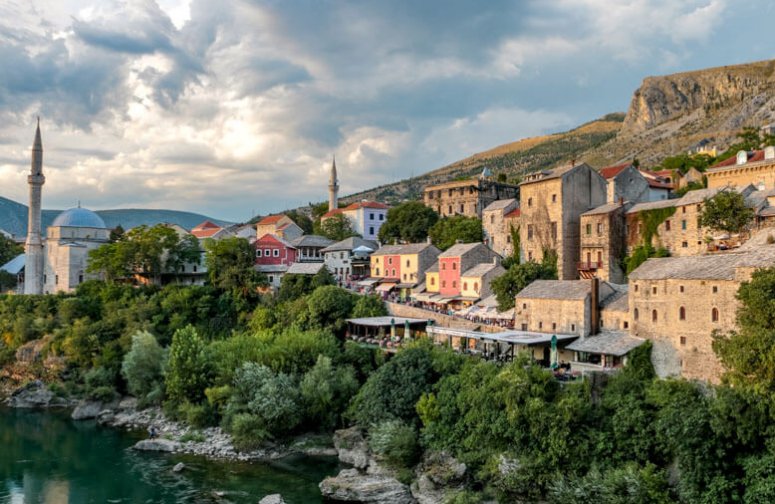 |
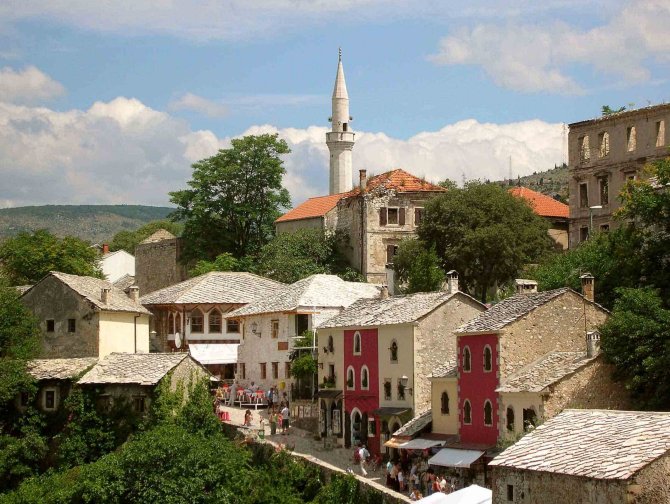 |
ArchitectureMostar has architecturally noteworthy buildings in a wide range of styles. Historicist architectural styles reflected cosmopolitan interest and exposure to foreign aesthetic trends and were artfully merged with indigenous styles. Examples include the Italianate Franciscan church, the Ottoman Muslibegovića house, the Dalmatian Ćorović House and an Orthodox church which was built as gift from the Sultan. The Ottomans used monumental architecture to affirm, extend and consolidate their colonial holdings. Administrators and bureaucrats – many of them indigenous people who converted from Christianity to Islam – founded mosque complexes that generally included Koranic schools, soup kitchens or markets. Out of the thirteen original mosques dating from the 16th and 17th centuries, seven have been lost during the 20th century for ideological reasons or by bombardment. One of the two 19th-century Orthodox churches has also disappeared, while the early 20th-century synagogue, after suffering severe damage in the World War II, has been converted into a theatre. Several Ottoman inns also survived, along with other buildings from this period of Mostar's history, such as fountains and schools. The majority of administrative buildings are from the Austro-Hungarian period and have neoclassical and Secessionist characteristics. A number of surviving late Ottoman houses demonstrate the component features of this form of domestic architecture – upper storey for residential use, hall, paved courtyard, and verandah on one or two storeys. The later 19th-century residential houses are predominantly in neoclassical style. A number of early trading and craft buildings still exist, notably some low shops in wood or stone, stone storehouses, and a group of former tanneries round an open courtyard. Once again, the 19th-century commercial buildings are predominantly neoclassical. A number of elements of the early fortifications are visible. Namely the Hercegusa Tower dating from the medieval period, whereas the Ottoman defence edifices are represented by the Halebinovka and Tara Towers – the watchtowers on the ends of the Old Bridge, and a stretch of the ramparts. During the period of Austro-Hungarian rule (1878–1918), Mostar’s city council cooperated with the Austro-Hungarians to implement sweeping reforms in city planning: broad avenues and an urban grid were imposed on the western bank of the Neretva, and significant investments were made in infrastructure, communications and housing. City administrators like Mustafa Mujaga Komadina were central players in these transformations, which facilitated growth and linked the eastern and western banks of the city. Noteworthy examples of Austro-Hungarian architecture include the Municipality building, which was designed by the architect Josip Vancaš from Sarajevo, Residential districts around the Rondo, and Gimnazija Mostar from 1902 designed by František Blažek. |
 |
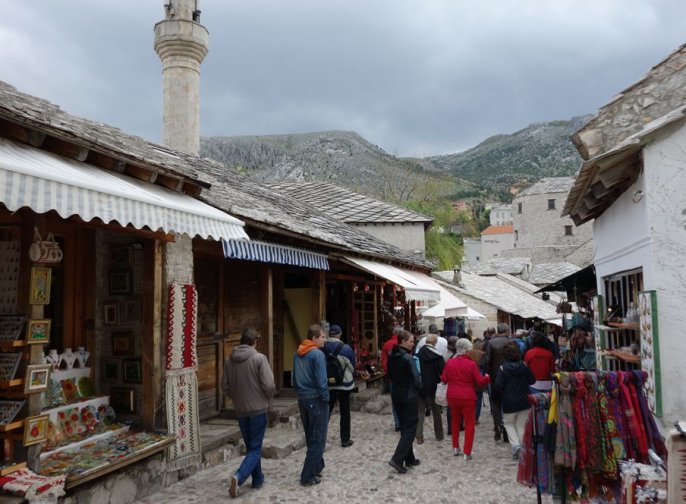 |
Since the end of the wider war in 1995, great progress has been made in the reconstruction of the city of Mostar. The city was under direct monitoring from a European Union envoy, several elections were held and each nation was accommodated with regard to political control over the city. Over 15 million dollars has been spent on restoration.A monumental project to rebuild the Old Bridge, which was destroyed during the Bosnian War, to the original design, and restore surrounding structures and historic neighbourhoods was initiated in 1999 and mostly completed by Spring 2004. The money for this reconstruction was donated by Spain (who had a sizable contingent of peacekeeping troops stationed in the surrounding area during the conflict), the United States, Turkey, Italy, the Netherlands, and Croatia. A grand opening was held on 23 July 2004 under heavy security. In parallel with the restoration of the Old Bridge, the Aga Khan Trust for Culture and the World Monuments Fund, with funding provided by the World Bank, undertook a five-year-long restoration and rehabilitation effort in historic Mostar. Realizing early on that the reconstruction of the bridge without an in-depth rehabilitation of the surrounding historic neighbourhoods would be devoid of context and meaning, they shaped the programme in such a way as to establish a framework of urban conservation schemes and individual restoration projects that would help regenerate the most significant areas of historic Mostar, and particularly the urban tissue around the Old Bridge. The project also resulted in the establishment of the Stari Grad Agency which has an important role in overseeing the ongoing implementation of the conservation plan, as well as operating and maintaining a series of restored historic buildings (including the Old Bridge complex) and promoting Mostar as a cultural and tourist destination. The official inauguration of the Stari grad Agency coincided with the opening ceremony of the Bridge. In July 2005, UNESCO inscribed the Old Bridge and its closest vicinity onto the World Heritage List. |
 |
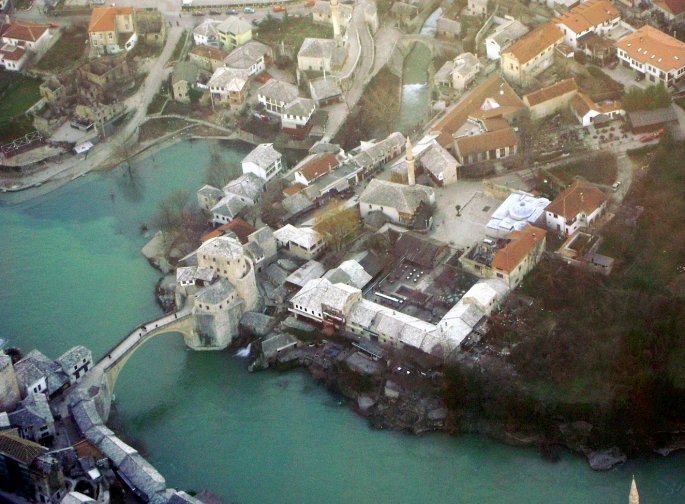 |
The oldest single arch stone bridge in Mostar, the Kriva Cuprija ("Sloping Bridge"), was built in 1558 by the Ottoman architect Cejvan Kethoda. It is said that this was to be a test before the major construction of the Stari Most began. The Old Bridge was completed in 1566 and was hailed as one of the greatest architectural achievement in the Ottoman controlled Balkans. This single-arch stone bridge is an exact replica of the original bridge that stood for over 400 years and that was designed by Hajrudin, a student of the great Ottoman architect Sinan. It spans 28.7 metres of the Neretva river, 21 metres above the summer water level. The Halebija and Tara towers have always housed the guardians of the bridge and during Ottoman times were also used as storehouses for ammunition. The arch is a perfect semicircle 8.56 metres in width and 4.15 metres in height. The frontage and vault are made of regular stone cubes incorporated into the horizontal layers all along the vault. The space between vault, frontal walls and footpath is filled with cracked stone. The bridge footpath and the approaching roads are paved with cobblestones, as is the case with the main roads in the town. Stone steps enable people to ascend to the bridge either side. During the armed conflict between Bosniaks and Bosnian Croats in the Bosnian War in the 1990s, the bridge was destroyed by the HVO (Croatian Defence Council).The Cejvan Cehaj Mosque, built in 1552, is the oldest mosque in Mostar. Later a madrasah (Islamic school) was built on the same compound. The Old Bazaar, Kujundziluk is named after the goldsmiths who traditionally created and sold their wares on this street, and still sells authentic paintings and copper or bronze carvings of the Stari Most, pomegranates (the natural symbol of Herzegovina) or the stećaks (medieval tombstones). The Koski Mehmed Paša Mosque, built in 1617 is open to visitors. Visitors may enter the mosque and take photos free of charge. The minaret is also open to the public and is accessible from inside the mosque. Just around the corner from the mosque is the Tepa Market. This has been a busy marketplace since Ottoman times. It now sells mostly fresh produce grown in Herzegovina and, when in season, the figs and pomegranates are extremely popular. Local honey is also a prominent specialty, being produced all around Herzegovina. Some noteworthy sites include Bishop’s Ordinariate building, the remains of an early Christian basilica at Cim, a hamam (Ottoman public bath), clock tower (sahat-kula), Synagogue (1889) and Jewish Memorial Cemetery, Nesuh-aga Vučjaković Mosque, Hadži-Kurt Mosque or Tabačica, Metropolitan's Palace (1908), Karagöz Bey Mosque (1557), Cathedral of the Holy Trinity (1873), Catholic Church and Franciscan Monastery, Ottoman Residences (16th–19th century), Crooked Bridge, Tara and Halebija Towers. The World War II Partisan cemetery in Mostar, designed by the architect Bogdan Bogdanović, is another important symbol of the city. Its sacrosanct quality is derived from the unity of nature (water and greenery) with the architectural expression of the designer; the monument was inscribed on the list of National Monuments in 2006. The Catholic pilgrimage site of Međugorje is also nearby as well as the Tekija Dervish Monastery in Blagaj, 13th-century town of Počitelj, Blagaj Fort (Stjepan-grad), Kravica waterfall, seaside town of Neum, Roman villa rustica from the early fourth century Mogorjelo, Stolac with its stećak necropolis and the remains of an ancient Greek town of Daorson. Nearby sites also include the nature park called Hutovo Blato, archeological site Desilo, Lake Boračko as well as Vjetrenica cave, the largest and most important cave in Bosnia and Herzegovina. |